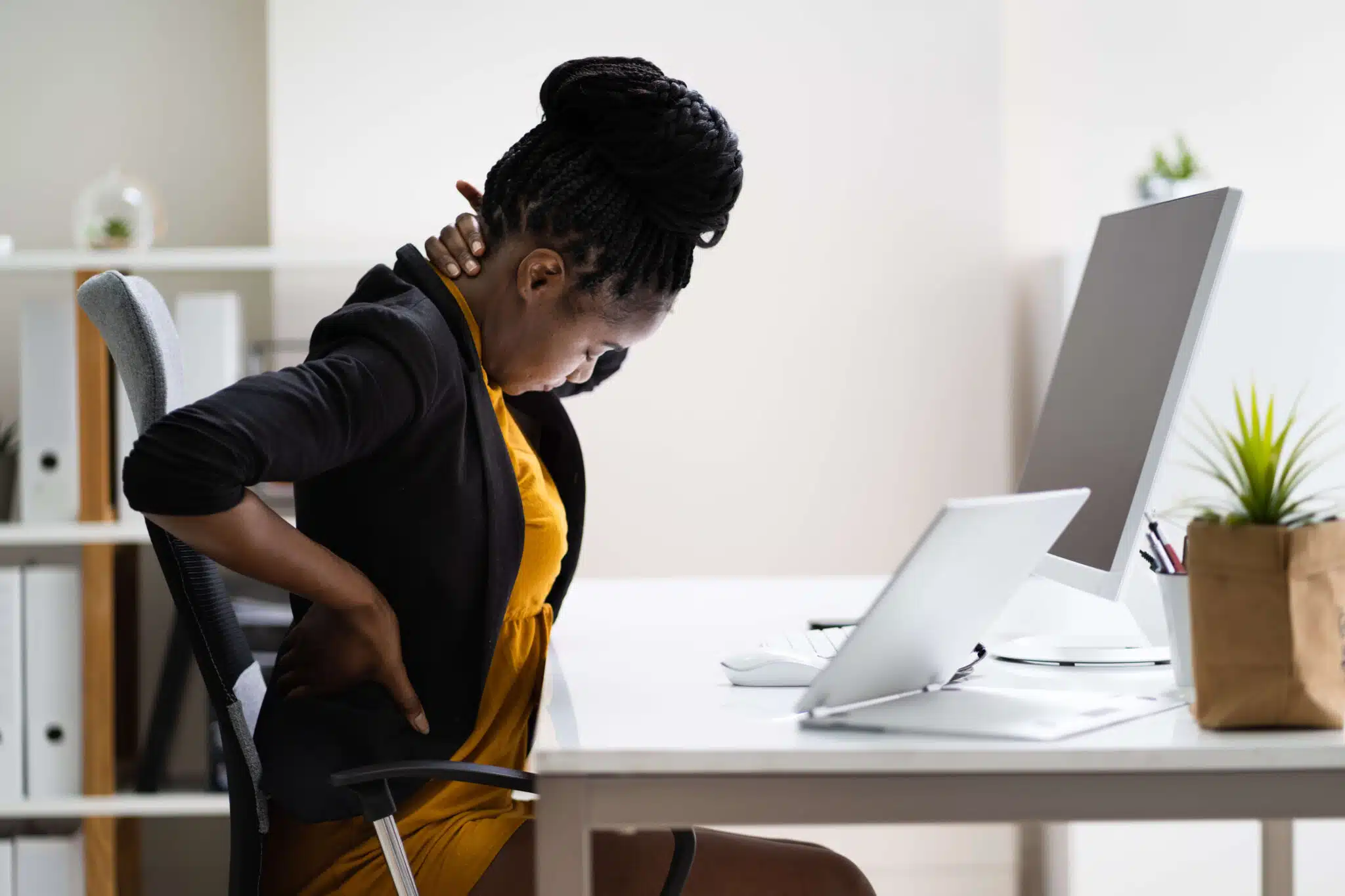Whether you work at a desk all day, are stuck in meetings, or face a long commute, you likely experience back pain from sitting. The concept may feel a bit paradoxical—sitting seems pretty easy and unlikely to cause muscle strain. However, sitting, particularly with poor posture, can cause strain on the spine and musculature. Developing lower back pain from sitting at a desk is so common that it’s called “office back pain.”
The best way to treat lower back pain from sitting is through prevention. Ergonomic seating at work and home, good posture, and plenty of back stretching and strengthening exercises can prevent the problem. These measures can also help to relieve back pain from sitting once it occurs. However, if you have spent years at a desk job, you may have caused musculoskeletal damage to your back. At that stage, regenerative therapy for low back pain may be your best bet for recovery.
Understanding Back Pain from Sitting
The human body evolved to stand, walk, run, and move throughout the day. Sitting for long stretches, such as at a desk, is a modern development that reduces blood circulation, causes joints to stiffen, tightens muscles, slows metabolism, weakens core muscles, and increases pressure on the intervertebral discs — the spine’s “shock absorbers.”
No wonder we get back pain from sitting!
What Causes Lower Back Pain from Sitting?
Sitting seems easy, so why is it so hard on our bodies?
When we stand, the spine’s natural curvature keeps our vertebrae properly aligned and supported. Meanwhile, our core muscles engage and move to support our torso as we stand and walk. However, when sitting, we tend to straighten or even reverse the proper spinal curve, causing the intervertebral discs to compress. At the same time, we no longer engage our core muscles, leaving the burden of supporting the weight of our trunk, arms, and head to fall on our lower back.
While we sit, our hip flexors, the muscles across the tops of our thighs, remain in a shortened position while our hamstrings are stretched. This unbalanced tension on the muscles pulls on the pelvis, causing strain across the lower back. The lack of movement while sitting causes these muscles and our joints to stiffen, adding to the back pain from sitting.
Common Symptoms
If your back hurts when sitting, the pain may claim your attention, but several symptoms may occur. You may experience a persistent, dull, aching pain that ebbs and flows yet seldom stops. Or you may have a sudden sharp pain upon moving or changing position. You may also experience tight muscles that make it difficult to move or bend, reducing your flexibility and range of motion.
Unfortunately, back pain from sitting can become more serious. Without rectifying the ergonomics of your workstation, improving stretching and exercise, or using regenerative therapies, you may experience disc degeneration or herniation as your back worsens.
How to Fix Lower Back Pain from Sitting
Fixing lower back pain from sitting requires ergonomic adjustments, lifestyle changes, exercising, and stretches.
Ergonomic Adjustments
If you work at a desk all day, choosing a chair that fits your body with good lumbar support is essential. Adjust the chair height so that your feet rest flat on the floor while your knees are at a 90-degree angle. Keep your monitor at eye level to avoid straining your neck, and position your keyboard and mouse so you can use them while maintaining a 90-degree angle at your elbows.
An ergonomic setup is not enough if you don’t maintain good posture. Also, consider trying a standing desk or even a treadmill walking desk to alleviate back pain from sitting and improve your overall health.
Regular Breaks and Stretches
Taking regular breaks every 30-60 minutes to stand, stretch, and walk around offers several benefits. It improves circulation and prevents blood from pooling in your legs, risking deep vein thrombosis (DVT). It also enhances your blood’s oxygen levels, helping you think more clearly and boosting your energy levels. It can also ease office back pain by reducing joint and muscle stiffness while relieving pressure on the discs of your spine.
In addition to easing back pain from sitting, these frequent, brief movement breaks can improve your mental focus, creativity, and mood. There are too many benefits to such breaks to miss them. Set a timer or use an app to remind you to move regularly.
The Role of Regenerative Medicine for Back Pain
Regenerative medicine is a drug-free, nonsurgical, and minimally invasive procedure that can help alleviate joint and muscle pain. It stimulates your body’s natural healing mechanisms and trains them on the source of your pain. Rather than block pain or mask it, regenerative medicine therapies facilitate the body’s tissue repair. Further, by reducing inflammation, it can relieve pain while boosting tissue health for long-term relief.
In many cases, people have used regenerative medicine to postpone or even replace surgery that was deemed “mandatory,” while others have used their treatments to speed their recovery from surgery.
Types of Regenerative Treatments
Regenerative medicine can treat back pain from sitting in a variety of ways. This natural medical approach stimulates the body’s healing abilities. These regenerative therapies work to improve and enhance damaged tissues and provide lasting pain relief.
Not to mention, every one of our biologic therapies is customized to each patient’s specific needs.
Benefits of Regenerative Medicine for Back Pain
Whether you experience back pain from sitting or an injury, regenerative medicine can help alleviate pain and reduce inflammation while working to improve tissue health. The goal is to restore mobility and function and improve your quality of life.
Personal Stories and Testimonials
QC Kinetix® patient testimonials are filled with stories of pain relief. Andy suffered from severe back pain for two years. Nearly continuous ice packs and antiinflammatories were not enough. Yet, within just six weeks of his regenerative therapy, he competed in an Iron Man competition and reported his pain level was down by 90%!
While most may not experience such dramatic results, consider Dina, who came to treat her lower back pain. She reports being 90% pain-free and able to sleep through the night. Imagine the enormity of such relief on her quality of life. If you experience back pain from sitting, an injury, or a degenerative condition, QC Kinetix’s regenerative medicine therapies may help.
Practical Tips to Prevent Back Pain
Life is too short to let lower back pain from sitting narrow your options. Take proactive steps to improve your back health starting today.
Daily Exercises
Daily exercise is critical for supporting and maintaining a healthy back. Incorporating stretching, yoga, and core strengthening routines to build and maintain flexibility and support your spine. Focus on movements that strengthen your abdominal, back, and hip muscles to stabilize your lower back.
Healthy Lifestyle Choices
In addition to swapping out your desk chair and favorite home lounge chair for ergonomically supportive options, practice good posture while sitting, standing, and walking. Maintain a healthy weight and stay well-hydrated to keep your spinal discs healthy. Eat a well-balanced whole-food diet and consider using joint health supplements.
Remember to take frequent breaks to stand, stretch, and walk around a bit when seated for an extended period, as this can help prevent back pain from sitting.

Regenerative Medicine: A Solution for Your Back Pain
If you’re dealing with back pain from sitting, regenerative medicine might be the solution you’ve been looking for. By addressing the root cause of your pain, these treatments can help you achieve lasting relief. Why continue to suffer? Explore regenerative medicine options today and take the first step toward pain relief.
Try QC Kinetix for Pain Relief
Ready to fix your lower back pain? Consult with a healthcare provider and consider scheduling an appointment with QC Kinetix today!


